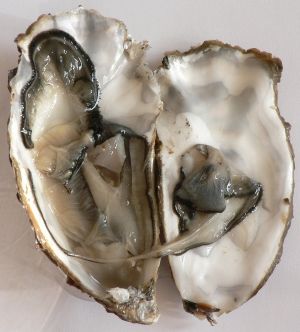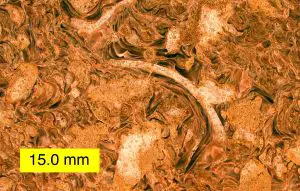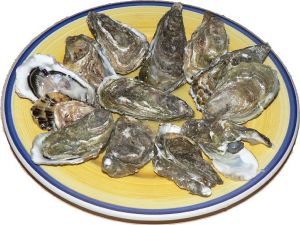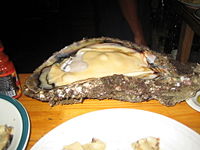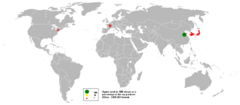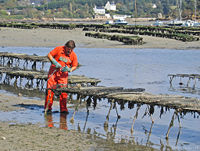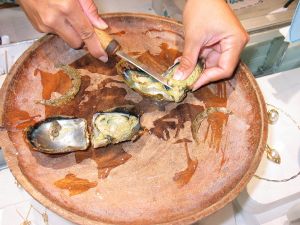Oyster
Oyster is the common name applied to various bivalve mollusks, and in particular the "true oysters" comprising family Ostreidae of the Ostreoida order and the pearl oysters of family Pteriidae (syn. Aviculidae) in the Pterioida order. The shell of oysters consists of two usually highly calcified valves (shells) that surround a soft body. Gills filter plankton from the water, and strong adductor muscles are used to hold the shell closed. Most oysters live in marine habitats or brackish water and are widely distributed in shallow, warm, coastal waters of the world's oceans.
The true oysters of family Ostreidae include many that are highly prized as food, consumed both raw and cooked. The pearl oysters of the Pteriidae genus Pinctada are well-known for producing large, commercially valuable pearls. On the other hand, the true oysters are incapable of making gem-quality pearls, although the opposite idea is a commonly-encountered misapprehension, often seen in illustrations or photographs where an edible oyster shell is mistakenly paired with a gem-quality pearl.
In addition to their commercial importance for culinary purposes and for the production of pearls, oysters provide important ecological values. Oyster reefs provide habitat for many organisms, and the oysters themselves provide food for various fish, marine mammals, and invertebrates. As filter feeders, they have a remarkable ability to filter water, removing pollutants and excess nutrients.
Despite these important functions for the ecosystem and humans, many oyster beds have been plundered without thought to future generations, with the overfishing resulting in serious decline in population size.
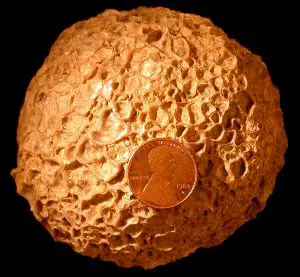
A number of bivalve mollusks other than edible oysters and pearl oysters also have common names that include the word "oyster." Among these are the "gryphaeate oysters" comprising family Gryphaeidae and the "thorny oysters" comprising family Spondylidae, both of which are placed in the Ostreoida order. The "tree oysters" are part of the Isognomonidae family in the Pterioida order. This article will provide an overview of the Ostreidae (true oysters) and Pteriidae (pearl oysters), with emphasis on the true oysters.
True oysters
The members of the family Ostreidae of order Ostreoida and class Bivalvia are the "true oysters," and include all the species that are commonly eaten under the title "oyster." There are about eight or nine genera in Ostreidae. The edible oysters mainly belong to the genera Ostrea, Crassostrea, Ostreola, or Saccostrea. Examples are the edible oyster (Ostrea edulis), eastern oyster (Crassostrea virginica), Olympia oyster (Ostreola conchaphila), Pacific oyster (Crassostrea gigas), Sydney rock oyster (Saccostrea glomerata), and the Wellfleet oyster (a variety of C. virginica).
Description
Like scallops (family Pectinidae), true oysters have a central adductor muscle, which means that the shell has a characteristic central scar, marking its point of attachment. The shell shape tends to be irregular as a result of attaching to other objects. Adult oysters become permanently attached to a hard surface early in development and lack a foot as an adult. An oyster's mature shape often depends on the type of bottom to which it is originally attached, but it always orients itself with its outer, flared shell tilted upward. One valve is cupped and the other is flat. The submerged shell opens periodically to permit the oyster to feed.
The two shells (valves) of oysters tend to be highly calcified. Members of genus Ostrea differ from most bivalves by having shells completely comprised of calcite but with internal muscle scars of aragonitic composition.
Oysters breathe much like fish, using both gills and mantle. The mantle is lined with many small, thin-walled blood vessels, which extract oxygen from the water and expel carbon dioxide. A small, three-chambered heart, lying under the adductor muscle, pumps colorless blood, with its supply of oxygen, to all parts of the body. At the same time two kidneys, located on the underside of the muscle, purify the blood of any waste products they have collected.
Oysters are filter-feeders, drawing water in over their gills through the beating of cilia. Suspended food plankton and particles are trapped in the mucus of a gill, and from there are transported to the mouth, where they are eaten, digested, and expelled as feces or pseudofeces. Feeding activity is greatest in oysters when the water temperatures are above 50°F (10°C). Healthy oysters consume algae and other water-borne nutrients, with each filtering up to five liters of water per hour.
Habitat and ecology
Members of genus Ostrea generally are subtidal and live continually immersed in sea water. They brood their fertilized eggs for various proportions of the period from fertilization to hatching. They do best in water with a not too thick concentration of phytoplankton.
Members of genera Saccostrea and Crassostrea live mainly in the intertidal zone, broadcast sperm and eggs into the sea, and can thrive in water that is very rich in phytoplankton. One of the most commonly cultivated oysters is Crassostrea gigas, the Pacific or Japanese oyster, which is ideally suited for oyster cultivation in seawater ponds.
Note that some tropical oysters in a different family, the family Isognomonidae, grow best on mangrove roots, and are exposed at low tide, making them easy to collect. In Trinidad in the West Indies, tourists are often astounded when they are told that in the Caribbean, "oysters grow on trees."
A group of oysters is commonly called a bed.
Reproduction and life history
There is no way of determining male oysters from females by examining their shells. While oysters have separate sexes, they may change sex one or more times during their life span. The gonads, organs responsible for producing both eggs and sperm, surround the digestive organs and are made up of sex cells, branching tubules, and connective tissue.
Both oviparous (egg bearing) and larviparous (larvae bearing) species are known within the Ostreidae. Both types are hermaphrodites. However, the larviparous species (which include the edible oyster, Ostrea edulis) show a pattern of alternating sex within each individual (sequential hermaphrodites), whereas the oviparous species (such as the eastern oyster, Crassostrea virginica) are simultaneous hermaphrodites, in which an individual may possess fully functional male and female gonads, producing either female or male gametes according to circumstances.
Oysters usually mature by one year of age. They are protandric, which means that during their first year they spawn as males (releasing sperm into the water). As they grow larger over the next two or three years and develop greater energy reserves, they release eggs, as females. Bay oysters are usually prepared to spawn by the end of June. An increase in water temperature prompts a few initial oysters to spawn. This triggers a spawning "chain reaction," which clouds the water with millions of eggs and sperm.
A single female oyster can produce up to 100 million eggs annually. The eggs become fertilized in the water and develop into larvae, which eventually find suitable sites on which to settle, such as another oyster's shell. Attached oyster larvae are called "spat." Spat are oysters 25 millimeters or less in length. Many species of bivalve, oysters included, seem to be stimulated to settle by the proximity of adults of their species.
The oyster's greatest predators include crabs, sea birds, sea stars, and humans. Some oysters contain live crabs, known as an oyster crab.
Importance
Ecological
As a keystone species, oysters provide habitat for an extensive array of marine life. The hard surfaces of oyster shells and the nooks between the shells provide places where a host of small animals can live. Hundreds of animals, such as anemones, barnacles, and hooked mussels use oyster reefs as habitat. Many of these animals, and the oysters themselves, serve as food for larger animals, including such commercially important fish such as striped bass, black drum, croaker, herring, and anchovies.
Filtering of water
As filter feeders, oysters are known for their role of filtering and removing pollutants and nutrients, such as nitrogen, from water. Scientists believe that the Chesapeake Bay's once-flourishing oyster populations historically filtered the estuary's entire water volume of excess nutrients in approximately three to four days. Today, with the decreased oyster populations, that process would take nearly a year (NOAA 2008), and sediment, nutrients, and algae can cause problems in local waters. Oysters filter these pollutants, and either eat them or shape them into small packets that are deposited on the bottom where they are harmless.
Oysters as food

Although eighteenth century author Jonathan Swift is often quoted as having said, "He was a bold man that first ate an oyster" (Herbst 2001), evidence of oyster consumption goes back into prehistory, as evidenced by oyster middens (debris of human activity) found worldwide. Archaeologists have found mounds of oyster shells dating back to 6950 B.C.E. and already by the first century B.C.E. they were being cultivated by a Roman engineer, Sergius Orata (Ecologist 2008). Oysters were an important food source in all coastal areas where they could be found, and oyster fisheries were an important industry where they were plentiful. Overfishing and pressure from diseases and pollution have sharply reduced supplies, but they remain a popular culinary dish and are celebrated in oyster festivals in many cities and towns.
Oysters can be eaten half shelled, raw, smoked, boiled, baked, fried, roasted, stewed, canned, pickled, steamed, broiled (grilled) or used in a variety of drinks. Preparation can be as simple as opening the shell and eating the contents including juice or adding butter and/or salt, or can be very elaborate. They are sometimes served on edible seaweed, such as brown algae. They are an exceptionally rich source of vitamin 12, a rich source of iron, selenium, vitamin D, calcium, and iodine, and a good source of protein and niacin, as well as a source of vitamins A, B1, and B2 (Bender and Bender 2005; Herbst 2001). Oysters are low in food energy; one dozen raw oysters contain approximately 110 kilocalories (460 kJ).
Unlike most shellfish, oysters can have a fairly long shelf-life: up to around two weeks; however, they should be consumed when fresh, as their taste reflects their age. For maximum shelf life, oysters should be stored out of water in refrigeration but not frozen and in 100 percent humidity. Oysters stored in water under refrigeration will open, utilize the small reserves of oxygen and die. Precautions should be taken when consuming them. Purists insist on eating oysters raw, with no dressing save perhaps lemon juice, vinegar (most commonly shallot vinegar), or cocktail sauce. Raw oysters are regarded like wines in that they have complex flavors that vary greatly among varieties and regions: some taste sweet, others salty or with a mineral flavor, or even like melon. The texture is soft and fleshy, but crisp to the tooth. This is often influenced by the water that they are grown in with variations in salinity, minerals, and nutrients.
Oysters are generally an expensive food in places where they are not harvested, and often they are eaten only on special occasions, such as Christmas. Whether oysters are predominantly eaten raw or cooked is a matter of personal preference. In the United States today, oysters are most often cooked before consumption, but there is also a high demand for raw oysters on the half-shell (shooters) typically served at oyster bars. Canned smoked oysters are also widely available as preserves with a long shelf life. Raw oysters were once a staple food for the poor in many countries with coastal access such as the United Kingdom and along the East Coast of the US and are thus still easily found in any areas bordering a sea or ocean. Oysters are commonly eaten raw in France in bars and as a "bar fast food" but the home use tends to be mixed with a large usage in cookingâsteamed or in paella or soups.
An alternative to opening raw oysters before consumption is to cook them in the shellâthe heat kills the oysters and they open by themselves. Cooked oysters are slightly sweet-tasting and considered savory, and all the different varieties are mostly equivalent. Oysters can be successfully cooked in a microwave oven.
A common food myth is that oysters are not suitable for eating during the summer months, and should only be eaten during months containing the letter "R" (in English). There are a few reasons why this myth actually has factual basis. First, months without "R" (May, June, July, and August) are the warmer months, and in warm months the oysters breed. This makes them less full bodied, less nutritious, and less enjoyable altogether. A health reason to not eat oysters in the warmer months is that the moment a raw oyster dies, it becomes tainted and poisonous. Consuming a dead raw oyster in the warm months make it harder to keep oysters alive on the plate. Another health issue is depending on the region of the oysters, they can contain harmful bacteria. Gulf Coast oysters do follow the "R rule" due to the fact that they contain high bacterial loads of human pathogens in these warm months, most notably Vibrio vulnificus and Vibrio parahaemolyticus. The main danger is with immuno-compromised individuals who will be unable to fight off these infections and will almost surely succumb to septicemia leading to death. Oysters are filter feeders and will naturally concentrate any anything present in the surrounding sea water. Vibrio vulnificus is the most deadly seafood-borne pathogen, with a higher case/death ratio than even Salmonella enterica and Escherichia coli.
In the early nineteenth century, oysters were very cheap and were mainly eaten by the working classes in the areas they were found. However, increasing demands from the rapidly-growing cities led to many of the beds running short. To increase production, foreign varieties were introduced and this soon brought disease, which, combined with pollution and increasing sedimentation, resulted in oysters becoming rare. This has been exacerbated worldwide by ever-increasing demands on wild oyster stocks (Clover 2004). This scarcity increased prices leading to their current status as a delicacy.
Oyster fishing
Oysters are fished by simply gathering them from their beds. A variety of means are used. In very shallow waters, they can be gathered by hand or with small rakes. In somewhat deeper water, long-handled rakes or oyster tongs are used to reach the beds. Patent tongs can be lowered on a line to reach beds which are too deep to reach directly. In all cases the manner of operation is the same: the waterman scrapes together a small pile of oysters, and then collects these by scooping them up with the rake or tongs.
In some areas, a dredge is used. This is a toothed bar attached to a chain bag. The dredge is towed through an oyster bed by a boat, picking up those oysters in its path. While dredges collect oysters more quickly, they can be very damaging to the oyster beds, and their use is in general strictly limited. In the state of Maryland, dredging was until 1965 limited to sailboats, and even since that date motor power can only be used on certain days of the week. These regulations prompted the development of specialized sailboats (the bugeye and later the skipjack) for dredging.
Oysters can also be collected by divers.
In any case, when the oysters are collected, they are sorted to eliminate dead shells, unwanted catch, and other debris. Then they are taken to market where they are either canned or sold live.
Oyster farming
Oysters have been cultured for a long time. Sergius Orata (fl. c. 95 B.C.E.) of the Roman Republic is considered to have been the first major merchant and cultivator of oysters. Using his very considerable hydraulic knowledge, in the first century B.C.E. he built a complex cultivation system including channels and locks to control the sea tides. He was famous for this, and Roman people used to say he was so good that he could breed oysters on the roof of his house (Holland 2003). A technique that he used to cultivate them in southern Italian lakes involved getting them to spawn on rock piles, with the larval oysters settling on twigs that were placed surrounding the rocks; when they grew to proper size, they were harvested (Economist 2008).
Two methods are commonly used today. In both cases, oysters are cultivated to the size of "spat," the point at which they attach themselves to a substrate. They may be allowed to mature further to form "seed" oysters. In either case they are then set out to mature. They may be distributed over existing oyster beds and left to mature naturally, to be collected using the methods for fishing wild oysters. Or they may be put in racks or bags and held above the bottom. The oysters are harvested by lifting the bags or rack to the surface and removing mature oysters. The latter method avoids losses to some predators, but is more expensive (LaMER 2008).
The Pacific (Japanese) oyster, Crassostrea gigas has also been grown in the outflow of mariculture ponds.
In many areas, non-native oysters have been introduced in attempts to prop up failing harvests of native varieties. For example, the eastern oyster was introduced to California waters in 1875, while the Pacific oyster was introduced there in 1929 (Conte). The Pacific oyster prospered in Pendrell Sound, BC, Canada, where the surface water is typically warm enough for spawning in the summer. Over the following years, spat spread out sporadically and populated adjacent areas. Eventually, possibly following adaptation to the local conditions, the Pacific oyster spread up and down the coast and now is the basis of the West Coast oyster industry. Proposals for further such introductions remain controversial.
Pearl oysters
"Pearl oysters" are members of the family Pteriidae (feathered oysters) of the order Pterioida and class Bivalvia. They are renowned for producing pearls of economic importance, valued as gemstones and also crushed and used in cosmetics or paint formulations. All types of oysters (and, indeed, almost all other shelled mollusks) can secrete concretions that are known by biologists as pearls. However, those that sometimes form in edible oysters are unattractive and lack any market value. However, both cultured pearls and natural pearls of value can be obtained from pearl oysters, as well as some other mollusks, such as freshwater mussels.
In nature, pearl oysters produce natural pearls by covering a minute invading parasite with nacre. Over the years, the irritating object is covered with enough layers of nacre to form what we know as a pearl. There are many different types and colors and shapes of pearl; these qualities depend on the natural pigment tone of the nacre, and the shape of the original irritant which was being covered over. The largest pearl-bearing oyster type is the saltwater Pinctada maxima, which is roughly the size of a dinner plate.
Pearls can also be cultivated by pearl farmers placing a nucleus, usually a piece of polished mussel shell, inside the oyster. In three to six years, the oyster will produce the desired pearl. These pearls are not as valuable as natural pearls, but externally appear exactly the same. (Cultured pearls and imitation pearls can be distinguished from natural pearls by X-ray examination.) Since the beginning of the twentieth century, when several researchers discovered how to produce artificial pearls, the cultured pearl market has far outgrown the natural pearl market. Natural pearls have become scarcer and scarcer and a necklace with only natural pearls can easily cost several hundred thousand (US) dollars.
ReferencesISBN links support NWE through referral fees
- Bender, D. A., and A. E. Bender. 2005. A Dictionary of Food and Nutrition. New York: Oxford University Press. ISBN 0198609612.
- Clover, Charles. 2004. The End of the Line: How Overfishing is Changing the World and What We Eat. London: Ebury Press. ISBN 0091897807.
- Conte, F. S. n.d. California oyster culture. University of California, Davis: Department of Animal Science. Retrieved January 6, 2009.
- Economist. 2008. Gem of the ocean: A dozen ocean-cleaners and a pint of Guinness, please. The Economist December 18, 2008. Retrieved January 6, 2009.
- Herbst, S. T. 2001. The New Food Lover's Companion: Comprehensive Definitions of Nearly 6,000 Food, Drink, and Culinary Terms. Barron's Cooking Guide. Hauppauge, NY: Barron's Educational Series. ISBN 0764112589.
- Holland, T. 2003. Rubicon: The Last Years of the Roman Republic. New York: Doubleday. ISBN 038550313X.
- Integrated Taxonomic Information System (ITIS). 1999a. Pterioida Newell, 1965 ITIS Taxonomic Serial No.: 79588. Retrieved January 6, 2009.
- Integrated Taxonomic Information System (ITIS). 1999b. Ostreoida ITIS Taxonomic Serial No.: 79856. Retrieved January 6, 2009.
- Integrated Taxonomic Information System (ITIS). 1999c. Ostreidae Rafinesque, 1815 ITIS Taxonomic Serial No.: 79866. Retrieved January 6, 2009.
- Louisiana Sea Grant College Program (LaMER). 2008. Oyster farming in Louisiana. Louisiana State University. Retrieved January 6, 2009.
- Malchus, N., and M. Aberhan. 1998. Transitional gryphaeate/exogyrate oysters (Bivalvia, Gryphaeidae) from the Lower Jurassic of northern Chile. Journal of Paleontology 72(4): 619-631.
- Maryland Department of Natural Resources. 2005. Oyster restoration projected to provide significant boost to bay grasses while removing nitrogen pollution from the bay. Maryland Department of Natural Resources. Retrieved January 6, 2009.
- National Oceanic and Atmospheric Administration (NOAA). 2008. Oyster reefs: Ecological importance. US National Oceanic and Atmospheric Administration. Retrieved January 6, 2009.
Credits
New World Encyclopedia writers and editors rewrote and completed the Wikipedia article in accordance with New World Encyclopedia standards. This article abides by terms of the Creative Commons CC-by-sa 3.0 License (CC-by-sa), which may be used and disseminated with proper attribution. Credit is due under the terms of this license that can reference both the New World Encyclopedia contributors and the selfless volunteer contributors of the Wikimedia Foundation. To cite this article click here for a list of acceptable citing formats.The history of earlier contributions by wikipedians is accessible to researchers here:
The history of this article since it was imported to New World Encyclopedia:
Note: Some restrictions may apply to use of individual images which are separately licensed.
